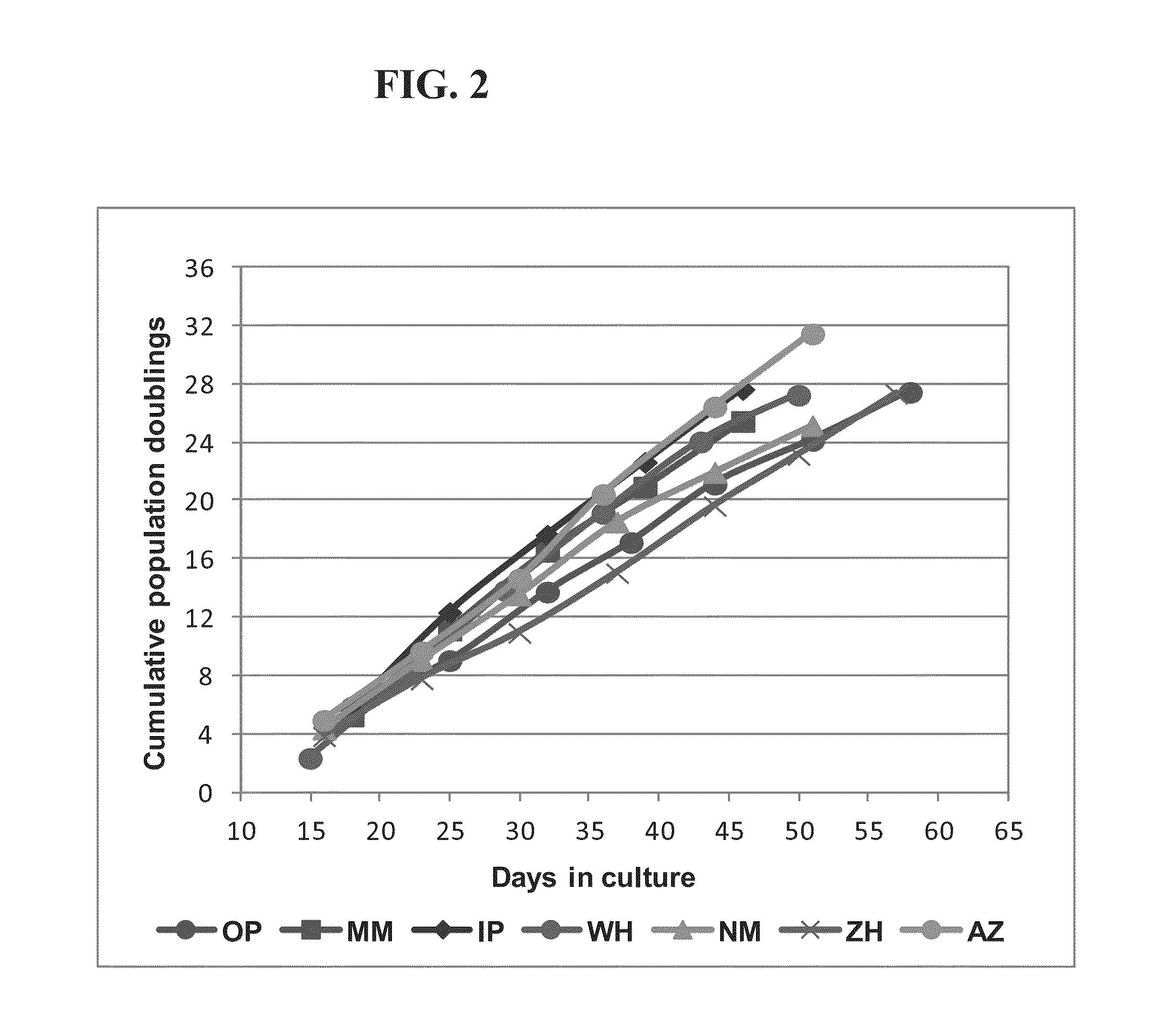Methods of generating mesenchymal stem cells which secrete neurotrophic factors
a technology of mesenchymal stem cells and neurotrophic factors, which is applied in the direction of skeletal/connective tissue cells, immunological disorders, metabolism disorders, etc., can solve the problems that the systematic or intrathecal administration of recombinant growth factors to als patients has not been effective, and achieves the effects of increasing expression, decreasing expression, and increasing expression
- Summary
- Abstract
- Description
- Claims
- Application Information
AI Technical Summary
Benefits of technology
Problems solved by technology
Method used
Image
Examples
example 1
Generation of Mesenchymal Stem Cells that Secrete Neurotrophic Factors (MSC-NTF)
[0304]In this non-limiting example, the production process for clinical grade mesenchymal bone marrow stromal cells, secreting neurotrophic factors (MSC-NTF) involves the following main steps:[0305]1. Bone marrow aspiration (BMA)[0306]2. Separation of the mononuclear cells (MNC)[0307]3. Enrichment and propagation of Multipotent Mesenchymal Stromal Cells (MSC)[0308]4. Induction of differentiation into MSC-NTF cells[0309]5. Harvesting of final product[0310]6. Product Packaging and labeling[0311]7. Product release for transplantation
[0312]Differentiation into MSC-NTF secreting cells may be induced between passages 2 to 6.
[0313]Bone Marrow Aspiration (BMA):
[0314]Fresh bone marrow was aspirated according to the routine Medical Center procedure from the patient's iliac-crest under local anesthesia and sedation by an anesthetist. Bone marrow (30-60 ml) was aspirated using aspiration needles into heparin contain...
example 2
MiRNA Analysis of Mesenchymal Stem Cells that Secrete Neurotrophic Factors (MSC-NTF)
[0377]The objectives of the study were to perform microRNA-based (miRNA) fingerprinting to characterize bone-marrow-derived MSCs and MSC-NTF cells of 4 independent, matched donor samples by identifying differences and similarities between the miRNA expression profiles and identifying key miRNAs that define the differences between the two cell types and determine how they are represented (i.e. neural / astrocytic differentiation pathways, as well as BDNF, GDNF, and VEGF expression and signaling).
[0378]The study identified a total of 160 miRNAs which were reliably detected across all the samples the donor-to-donor variability evident via miRNA profiling was relatively low and Principal Component Analysis (PCA) revealed that sample set formed distinct clusters based on cell type.
Statistical comparisons of the miRNA profiles for the two different cell types identified 41 differentially-expressed (DE) key m...
example 3
Quantitative PCR Validation Study
[0434]Sample Processing and Quality Control:
[0435]All total RNA samples were checked for concentration, yield and quality of RNA. RNA QC was performed using Agilent 2200 TapeStation and the R6K Screen Tapes and Reagents following Sistemic's SOP (SSOP27) to determine RIN.
[0436]The 8 samples used in Phase I were previously checked for quantity and quality of RNA.
[0437]QPCR Profiling and Data Analysis:
[0438]QPCR was carried out using miRCURY LNA™ Universal RT microRNA PCR methodology and reagents (Exiqon A / S) following instruction manual v 5.1; Protocol A—Individual Assays. Briefly, cDNA was synthesised using 5 ng / ul of starting RNA template. An LNA™ RNA Spike-in control RNA was added to each sample. The expression levels of the candidate miRNAs (kmiRs™) were measured in technical triplicates for all samples of interest using miRNA specific primer sets.
[0439]A positive control (measures the expression of LNA™ RNA-Spike-in control) and ‘no RNA template’ ...
PUM
| Property | Measurement | Unit |
|---|---|---|
| concentration | aaaaa | aaaaa |
| concentration | aaaaa | aaaaa |
| concentration | aaaaa | aaaaa |
Abstract
Description
Claims
Application Information
 Login to View More
Login to View More - R&D
- Intellectual Property
- Life Sciences
- Materials
- Tech Scout
- Unparalleled Data Quality
- Higher Quality Content
- 60% Fewer Hallucinations
Browse by: Latest US Patents, China's latest patents, Technical Efficacy Thesaurus, Application Domain, Technology Topic, Popular Technical Reports.
© 2025 PatSnap. All rights reserved.Legal|Privacy policy|Modern Slavery Act Transparency Statement|Sitemap|About US| Contact US: help@patsnap.com



